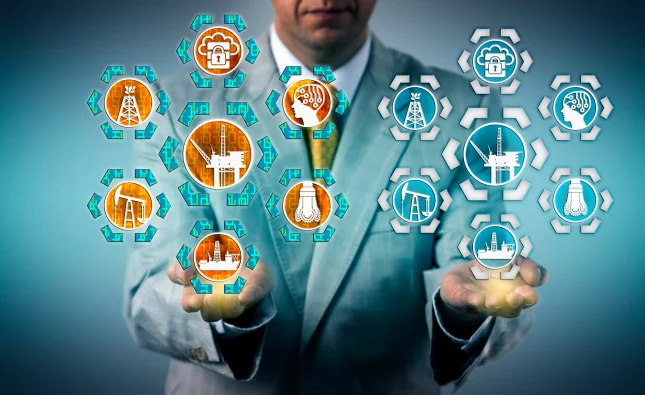
Being able to get things and services with just a few clicks has changed the way people shop. The industry has recently seen a lot of tech-driven changes that have made things run more easily, improved the customer experience, and given all kinds of businesses more chances to make sales. E-commerce is always changing because of new technology that makes it faster, more quick, and more fun. Personalized shopping made possible by AI and shopping experiences based on virtual reality are two examples.
Nearly $8 trillion will be spent on online shopping around the world by 2026. Firms must use these new tools to stay ahead of the competition and adapt to the changing wants of online shoppers. This article talks about some major technological advances, their benefits, and real-life cases that show how these advances are changing the way people shop online.
Improvements in Technology for Online Shopping

A host of innovations are changing how e-commerce businesses operate, with a focus on creating personalized, secure, and streamlined experiences for consumers.
A. Artificial Intelligence and Machine Learning
Artificial Intelligence (AI) and Machine Learning (ML) have become integral to e-commerce, offering enhanced personalization, smarter recommendations, and improved customer support.
- Personalization: AI-driven algorithms analyze a customer’s behavior, preferences, and purchase history to deliver tailored product recommendations. This personalization boosts customer satisfaction and conversion rates.
- Smart Search: AI enables predictive search capabilities, making it easier for customers to find what they need. Algorithms can also handle typo corrections and suggest relevant products.
- Customer Support: AI-powered chatbots are becoming more sophisticated, handling common inquiries, providing recommendations, and freeing up customer service agents for more complex queries.
B. Augmented Reality (AR) and Virtual Reality (VR)
AR and VR technology allow customers to experience products virtually, creating a try-before-you-buy experience that reduces returns and improves satisfaction.
- Virtual Fitting Rooms: AR enables customers to visualize clothing, accessories, or even furniture in their space before making a purchase. This technology is especially popular in fashion and home decor.
- Product Demos: VR lets customers experience products more immersively. For example, car brands are using VR showrooms to give customers a virtual experience of their vehicles from home.
C. Voice Commerce
Voice commerce has gained traction as voice-activated devices become common. This enhancement allows customers to shop hands-free, using voice commands to search, place orders, and track deliveries.
- Hands-Free Shopping: With smart speakers like Amazon Alexa and Google Home, customers can add items to their cart, place orders, or check delivery statuses without lifting a finger.
- Voice Search Optimization: To leverage voice commerce, e-commerce platforms are optimizing for voice search to ensure customers can easily find their products through spoken queries.
D. Advanced Analytics and Data-Driven Insights
Analytics tools have become critical in understanding customer behavior, tracking sales performance, and identifying growth opportunities.
- Predictive Analytics: By analyzing past purchase data, predictive analytics can help forecast trends, optimize inventory, and ensure popular items remain stocked.
- Customer Insights: Analytics platforms provide deep insights into customer behavior, allowing businesses to optimize their marketing efforts and personalize interactions.
E. Blockchain and Enhanced Security

Blockchain technology is enhancing security in e-commerce by creating transparent and immutable transaction records, building customer trust, and reducing fraud.
- Transparent Transactions: Blockchain enables customers to verify the authenticity of products, particularly in sectors like luxury goods where counterfeit products are a concern.
- Data Privacy and Security: Blockchain offers a secure platform for transactions, safeguarding customer data and reducing the risk of breaches.
Benefits of Tech Enhancements in E-commerce
These technological advancements provide numerous benefits that improve both operational efficiency and customer experiences:
A. Improved Customer Experience and Engagement
Tech enhancements like personalization and AR provide a more interactive shopping experience, which increases customer satisfaction and retention. With these tools, businesses can create unique shopping journeys, addressing individual preferences and boosting engagement.
B. Higher Conversion Rates and Reduced Returns
AI-driven product recommendations and virtual try-ons help customers make informed purchase decisions, which results in higher conversion rates and lower return rates. For instance, customers can see how a product looks in their space or try on clothing virtually, reducing the likelihood of dissatisfaction upon delivery.
C. Increased Operational Efficiency
Technological advancements like predictive analytics and AI-powered customer support streamline business operations. Automation tools allow companies to focus on core functions, while data-driven insights help optimize supply chains and inventory management.
D. Enhanced Security and Fraud Prevention
Blockchain technology provides greater transparency and data security, reducing fraud risks. Secure transactions build customer trust, which is essential for long-term loyalty.
Case Studies: Success Stories in Tech-Enhanced E-commerce
Real-world examples highlight how businesses are using tech enhancements to drive growth and improve customer experiences:
The Augmented Reality Shopping Experience at Sephora
Global beauty company Sephora used augmented reality to improve online purchasing. Customers can virtually test on makeup products using the brand’s “Virtual Artist” app. Seeing how various lipstick or eyeshadow tints appear in real time gives users more confidence when making purchases online. Consequently, Sephora witnessed a rise in customer interaction and a decrease in refunds, demonstrating the potential of augmented reality to enhance the shopping experience.
Amazon’s Voice Commerce with Alexa
Amazon has leveraged its Alexa smart speaker to lead the way in voice commerce. Customers can search for products, add items to their cart, reorder previous purchases, and track orders using voice commands. Amazon’s early investment in voice commerce has led to millions of voice-activated orders and set a standard for other retailers looking to enter the voice shopping arena.
Nike’s Use of Predictive Analytics

Nike improves inventory levels and minimizes stockouts by using predictive analytics to comprehend purchasing trends and forecast demand. Nike determines popular styles and sizes by evaluating consumer data. By keeping these items in stock, Nike improves customer satisfaction. Nike gained a competitive edge in a market that moves quickly thanks to this strategy, which also helped the company anticipate sales more accurately.
Overstock’s Blockchain-Powered Security
Overstock, an online retailer, adopted blockchain to enhance transaction transparency and secure customer data. Using blockchain technology, Overstock allows customers to verify product authenticity, which is especially valuable in high-value product categories. This technology has strengthened customer trust, reduced the risk of fraud, and positioned Overstock as a leader in secure e-commerce.
IKEA’s Virtual Reality Showrooms
IKEA’s virtual reality showrooms allow customers to experience furniture placement in a virtual room. This VR feature gives shoppers a realistic sense of how items fit in their homes, addressing a common pain point in online furniture shopping. IKEA’s virtual showrooms have increased customer confidence in online purchases, which has translated into higher sales and reduced returns.
Challenges and Considerations with E-commerce Enhancements
While technological enhancements offer significant benefits, they also come with challenges that businesses must address:
A. High Initial Costs of Implementation
Adopting technologies like AR or blockchain requires substantial initial investments. Small and medium-sized businesses may face barriers to entry due to these costs, although scalable solutions are increasingly available.
B. Privacy Concerns and Data Security
With the rise of AI and data analytics, data privacy is a critical concern. Companies must comply with data protection regulations and implement strong security measures to protect customer information and maintain trust.
C. Technology Integration and Scalability Issues
Integrating new technologies with existing e-commerce platforms can be challenging. Businesses need to ensure that their systems are compatible and scalable to accommodate future growth and tech advancements.
D. Voice Search Optimization for E-commerce

While voice commerce is growing, optimizing product listings and search functions for voice commands requires specialized SEO tactics. This additional requirement adds to the complexity of maintaining a voice-optimized online store.
The Future of E-commerce with Tech Innovations
The future of e-commerce will be marked by increased use of artificial intelligence, personalization, and immersive shopping experiences. Technologies like 5G will drive faster connectivity, supporting advanced features like AR and VR. Blockchain’s role will likely expand, with decentralized transactions becoming more prevalent in e-commerce.
Additionally, as more consumers shift to mobile shopping, mobile optimization and voice-assisted shopping will become indispensable. AI will continue to evolve, offering deeper personalization capabilities and potentially integrating with IoT devices to create a seamless shopping experience across all platforms.
Final Thought
Tech e-commerce by developing engaging, safe, and customized shopping experiences that meet the demands of contemporary consumers, innovations are reshaping the retail industry. These technologies, which range from AI-driven personalization and AR-powered try-ons to the safe transactions made possible by blockchain, provide substantial advantages to both consumers and companies.
Businesses who invest in these advances stand to gain a competitive edge, boost consumer loyalty, and enhance operational efficiency as e-commerce develops further. Businesses may match present customer demands and get ready for the future of online purchasing by adopting these innovations.
The possibilities for improving e-commerce are numerous, and as technology develops, it will become increasingly difficult to distinguish between online and physical purchasing, providing hitherto unheard-of levels of convenience and interaction. E-commerce has arrived and holds great promise for both consumers and businesses.










